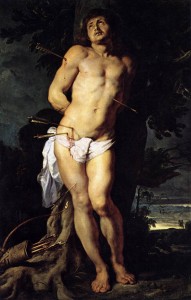I was flipping through the just-arrived October 8 issue of The New Yorker this morning when a poem by Billy Collins caught my eye. (You'll find it on pp. 88-89, or here, if you're a subscriber.) It's called "Table Talk," and it recounts a conversation over dinner about "applying the paradoxes of Zeno to the martyrdom of St. Sebastian." An excerpt:
If, the man with the tie continued,
an object moving through space
will never reach its destination because it is always
limited to cutting the distance to its goal in half,
then it turns out St. Sebastian did not die
from the wounds inflicted by the arrows.
No, the cause of death was fright at the spectacle of their endless approach.
St. Sebastian, according to Zeno, would have died of a heart attack.
 I don't know much about Zeno, but I do have some news for the man with the tie: St. Sebastian really did not die from his arrow wounds. Not according to the legend, anyway. He was left for dead but recovered, miraculously, and was eventually beaten to death by order of Diocletian (who was understandably annoyed by the failure of that first attempt on Sebastian's life).
I don't know much about Zeno, but I do have some news for the man with the tie: St. Sebastian really did not die from his arrow wounds. Not according to the legend, anyway. He was left for dead but recovered, miraculously, and was eventually beaten to death by order of Diocletian (who was understandably annoyed by the failure of that first attempt on Sebastian's life).
Collins refers, in the final stanza of his poem, to Sebastian's attempted-martyrdom-by-arrows as "that popular subject of religious painting," and he's certainly right about that. The echoes of Christ's crucifixion (another false-ending image...) are irresistibly dramatic. And, of course, artists were once eager to embrace any acceptable excuse to paint the unclothed human form, and what better excuse than the noble suffering of a bare-chested young soldier? But the fact that he survived the ordeal is an important part of the context for those paintings.
The painting above is by Peter Paul Rubens -- from the era when the arrows themselves became something of an afterthought. For what it's worth, the nursing and recovery of Sebastian following the archery incident has also been depicted many times by many artists -- and I've seen images of the later, successful murder-by-clubbing (usually as part of a cycle of scenes from Sebastian's life). If you're interested in the development of the cult of Sebastian, in prayer and in art, you can find more information and lots of lovely illustrations in Robert Kiely's new book Blessed and Beautiful. Kiely's essay "Picturing the Magdalene" recently appeared in our pages, and his book includes a chapter titled "Manliness and Saintliness: The Cases of Mark, Sebastian, and Rocco."
Update (10/25): another blogger has discovered that this thought experiment, complete with erroneous assumption about Sebastian's fate, isn't original to Collins -- he seems to have borrowed it (uncredited) from Tom Stoppard.
Please email comments to [email protected] and join the conversation on our Facebook page.
Share
Previous Story
The Validity of Absolutes
Next Story
MN priest on archbishop's anti-gay-marriage mailing: bad move.
